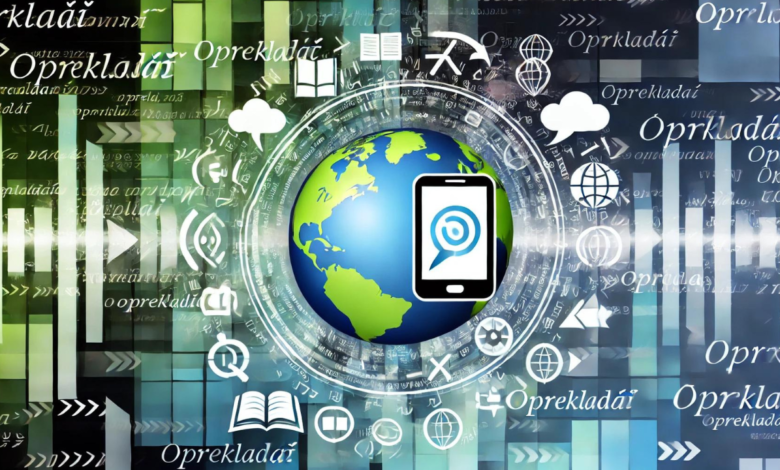Oprekladač: The Ultimate Guide to Translation Tools

Given how linked the world is now, linguistic obstacles may be significant. Whether you’re a student, a professional, or a traveller, understanding and communicating in multiple languages is essential. This is where translation tools come into play, and one of the rising stars in this domain is the oprekladač.
What is Oprekladač?
The term oprekladač is derived from Slavic languages, where “prekladač” means “translator.” Oprekladač can refer to various online or software-based translation tools designed to convert text from one language to another. These tools are indispensable in today’s globalized world, enabling users to break down language barriers quickly and efficiently.
The Importance of Translation Tools
Language is the foundation of communication, but with over 7,000 languages spoken globally, it is not only possible for them. Translation tools like oprekladač help bridge this gap, allowing users to understand and convey messages across different languages. These tools are essential for:
- Business Communication: In today’s interconnected world, organizations often deal with clients, suppliers, and partners worldwide. Oprekladač helps ensure that communication is clear and compelling, reducing the risk of misunderstandings.
- Education: Students and educators frequently encounter texts in foreign languages. Translation tools can assist in understanding and interpreting academic material, making learning more accessible.
- Travel and Tourism: Travelers visiting foreign countries often face language barriers. Oprekladač can be a handy tool for translating signs, menus, and basic conversations, enhancing the travel experience.
- Personal Use: Whether learning a new language or trying to understand a foreign document, a translation tool like oprekladač can be valuable.
Features of Oprekladač
Oprekladač tools typically offer a range of features designed to make translation easy and effective. Some of the key features include:
- Multi-language Support: Most oprekladač tools support a wide range of languages, allowing users to translate between numerous language pairs.
- Text and Speech Translation: Besides text translation, many tools offer speech recognition and translation, enabling real-time communication in different languages.
- Offline Capabilities: Some oprekladač tools allow users to download language packs for offline use, making them convenient for travellers without constant internet access.
- Contextual Translation: Advanced oprekladač tools use machine learning and AI to understand the context of a sentence, providing more accurate translations.
- User-friendly Interface: These tools often feature intuitive interfaces that even people with no technical knowledge can use.
How to Use Oprekladač Effectively
While oprekladač tools are powerful, using them effectively requires some understanding of their limitations and best practices:
- Understand the Limitations: Machine translation is not perfect. While oprekladač can provide a quick and rough translation, reviewing and editing the output is essential, especially for formal documents.
- Use Simple Words: The more intricate the phrase, the more likely it is to be mistranslated. Try to use clear, straightforward language when using oprekladač tools.
- Double-Check Key Terms: Proper nouns, technical terms, and idioms can often be mistranslated. Double-check these terms to ensure accuracy.
- Take Advantage of Customization Options: Some oprekladač tools allow users to create custom dictionaries or glossaries, which can be particularly useful for specialized fields.
- Pair with Human Translation: For critical documents or sensitive communication, consider using oprekladač as a first step, followed by human translation, to ensure accuracy and nuance.
Popular Oprekladač Tools
Several oprekladač tools are available, each with its strengths and weaknesses. Here are some of the most popular ones:
- Google Translate: Perhaps the most well-known translation tool. With compatibility for more than 100 languages, Google Translate provides text and speech translation. Its machine-learning algorithms continually improve the accuracy of translations.
- DeepL Translator: Known for its high-quality translations, DeepL uses neural networks to provide more nuanced and context-aware translations. It supports fewer languages than Google Translate but is often more accurate.
- Microsoft Translator: Integrated with Microsoft Office and other Microsoft products, this tool is ideal for business users. It offers text, speech, and even image translation.
- Yandex. Translate: Yandex is a popular choice in Russia and Eastern Europe. Translate supports many languages and offers features like offline translation and predictive typing.
- iTranslate: A versatile tool that provides voice translation, offline capabilities, and a phrasebook feature. It may be found on many platforms like iOS, Android, and the web.
The Future of Oprekladač
As technology continues to advance, the future of oprekladač looks promising. Using natural language processing, machine learning, and artificial intelligence developments, translation tools are becoming increasingly accurate and versatile. Here are some trends to watch for:
- Improved Contextual Understanding: Future oprekladač tools will better recognize the background of a letter or conversation, leading to more accurate translations.
- Integration with Augmented Reality (AR): Imagine your smartphone’s camera at a non-English sign and seeing the translation overlaid in real-time. This is becoming a reality with AR technology.
- Personalized Translation: As oprekladač tools gather more data, they can provide more customized translations based on a user’s preferences, language level, and usage patterns.
- Increased Accessibility: With more languages and dialects being added, oprekladač tools will become accessible to a broader audience, helping to preserve and promote linguistic diversity.
- Ethical Considerations: As machine translation becomes more prevalent, there will be discussions around ethical considerations, such as the potential for translation bias and the impact on professional translators.
Conclusion
Oprekladač tools have revolutionized communication across languages, making the world smaller and more connected. Whether you’re a business professional, a student, or a traveller, these tools offer invaluable assistance in navigating language barriers. As technology develops, we should anticipate even more sophisticated and accurate translation tools in the future.
You May Also Read: Преводсч: Exploring the Meaning and Context




